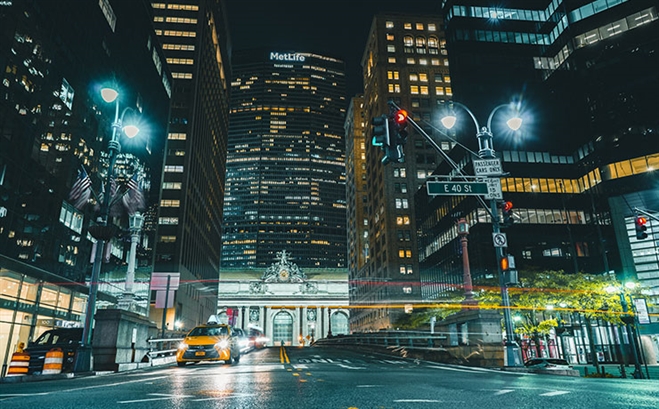How NYC Crunches Taxi Data
December 19, 2019 by Melissa Crowe

Photo credit: Nan Palmero/Flickr
For decades, New York City has been known for its iconic yellow taxis, which can be hailed with a raised arm or a piercing whistle. But in recent years, far more for-hire cars are driving the streets of the city. In addition to yellow taxis, there are lime-green taxis, black livery cars, and vehicles in every color of the rainbow from app-based companies like Uber and Lyft.
Fausto Lopez, Policy Analytics Manager for NYC's Taxi and Limousine Commission (TLC), shared the complexity of the for-hire vehicles options in New York, along with some of the data the TLC collects and how that data is used.
What Data Does the TLC Collect?
The Taxi and Limousine Commission regulates the the city's taxis, both yellow and green, along with for-hire vehicles, which include app-based companies. (New York's green taxis, like the yellow ones, can be hailed on the street, but only in Upper Manhattan or the outer boroughs — Brooklyn, Queens, Staten Island, and the Bronx — which are underserved by yellow taxis.)
All told, the TLC oversees roughly 128,000 vehicles, which take passengers on upwards of 1 million trips each day.
The TLC collects trip-level data on passengers' rides in yellow and green taxis, along with some vehicles in the for-hire industry. This includes information on the vehicle, the trip's start point and destination, the fare, and the duration of the trip.
All this data is used to further the TLC's mission: to protect both drivers and passengers and preserve public safety. Take fatigue, for instance, when drivers have long shifts and do not get sufficient sleep, crashes become more likely. By examining trip-level data, the TLC was able to ascertain that some drivers were behind the wheel too long, and set a policy to regulate shift length.
In NYC, several app-based platforms operate. Lyft and Uber are the most well known, but Via and Juno are also available. Many drivers work for two or more of these companies.
"That's really important to understand, because there are implications to that kind of work behavior," points out Lopez. While the app-based companies can track driver's hours behind the wheel for their company, the TLC sees a more global view, showing the driver's hours across all companies. The data also reveals that the percent of drivers working for two or three platforms is on the rise.
The TLC's data is shared publicly on the city's Socrata-powered portal. You can see, for instance, a list of all TLC-licensed for-hire vehicle drivers and the application status of new drivers. Also available: trip-level information, by year, for green taxis, yellow taxis, and for-hire vehicles.
NYC's Changing Transportation Market
When Uber arrived in New York City about a decade ago, it changed the market. While yellow taxi cabs are tightly regulated, a medallion is required, which limits the number of taxis on the road. Uber, and the other app-based companies, have grown without such limitations.
Since the apps began operating in NYC, the number of trips taken by yellow taxi drivers has fallen, while the number of app-based rides has grown. One big impact of the growing volume of for-hire vehicles is their ability to pick up and drop-off passengers in traditionally underserved neighborhoods.
Of course, as dominant as they are, taxis and for-hire vehicles (from the yellow to the app-based services) are just one piece of New York City's transportation network. The city also has a 24-hour public transportation. How do all these ways of getting around work together? As there are increases in rides for for-hire vehicles in East New York, does ridership to nearby train stops fall?
Thinking about the big picture of NYC transportation, Fausto said, "We [cities] have to think of ourselves as one functioning organism instead of each agency functioning on its own. If you can do that, you can create a powerful agency for change and innovation."
We [cities] have to think of ourselves as one functioning organism instead of each agency functioning on its own. If you can do that, you can create a powerful agency for change and innovation.
Fausto Lopez
Policy Analytics Manager for NYC's Taxi and Limousine Commission
The New York City Council passed legislation in August 2018 on for-hire vehicles, which was signed into law by the city's mayor. For one year, no licenses would be issued for new for-hire vehicles except those that are wheelchair-accessible. This temporary cap on expansion was tied to an examination of the impact of for-hire vehicles impact on the city. This bill required the Taxi and Limousine Commission to study and decide whether to adopt vehicle utilization standards or regulations on the number of for-hire vehicle licenses, notes the City Council press release.